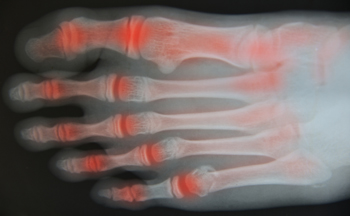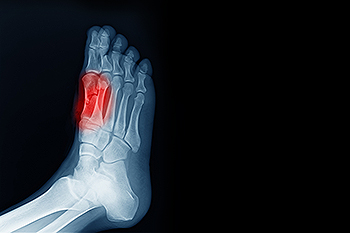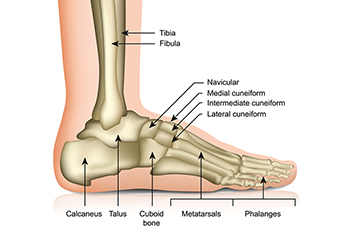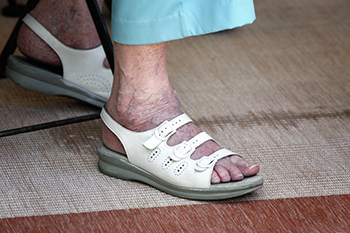Items filtered by date: January 2023
Psoriatic Arthritis and Foot Care

Psoriatic arthritis is a specific kind of arthritis that is connected with a skin and nail disease named psoriasis. Individuals living with psoriatic arthritis, or any kind of arthritis, should take extra special care of their feet because of the foot conditions they are susceptible to. If you are living with psoriatic arthritis, consider taking proper care of your feet by keeping them dry, as opposed to wet or moist. When the feet are moist, they essentially become a breeding ground for a host of different fungi and bacteria. Therefore, be sure that the shoes and socks you are wearing are dry and lack any kind of damaging moisture. Additionally, if you are living with psoriatic arthritis, consider wearing shoes that are safe and comfortable. Although it may go without saying, shoes that are too tight or have heels that are too high can put individuals at an increased risk of developing a detrimental foot condition. Contact a podiatrist today if you are living with arthritis.
Arthritis can be a difficult condition to live with. If you are seeking treatment, contact Charles Perry, DPM from Ohio. Our doctor can provide the care you need to keep you pain-free and on your feet.
Arthritic Foot Care
Arthritis is a joint disorder that involves the inflammation of different joints in your body, such as those in your feet. Arthritis is often caused by a degenerative joint disease and causes mild to severe pain in all affected areas. In addition to this, swelling and stiffness in the affected joints can also be a common symptom of arthritis.
In many cases, wearing ill-fitting shoes can worsen the effects and pain of arthritis. Wearing shoes that have a lower heel and extra room can help your feet feel more comfortable. In cases of rheumatoid arthritis, the arch in your foot may become problematic. Buying shoes with proper arch support that contour to your feet can help immensely.
Alleviating Arthritic Pain
- Exercises that stretch the foot can prevent further pain and injury and increase mobility
- Most of the pain can be alleviated with anti-inflammatory drugs, heat, and topical medications
- Massages can help temporarily alleviate pain.
It is best to see your doctor for the treatment that is right for your needs and symptoms. Conditions vary, and a podiatrist can help you determine the right method of care for your feet.
If you have any questions, please feel free to contact our offices located in Cambridge and Zanesville, OH . We offer the newest diagnostic tools and technology to treat your foot and ankle needs.
Heel Pain Can Be Treated!
Sesamoiditis and Foot Pads

Sesamoiditis is a particular kind of foot affliction in which the two small sesamoid bones located in the ball of the feet become inflamed and aggravated. Sometimes, individuals living with sesamoiditis may experience some kind of pain due to their condition. If the individual is prone to engage in activity that puts a significant amount of pressure on the balls of the feet, then pain from sesamoiditis is even more likely. Patients with sesamoiditis will often wonder how they can mitigate the pain caused by the condition. One potential option is to wear sesamoiditis insoles that are like pads for the feet. Some of these foot pads wrap around and support the ball of the foot. These insoles are useful because they can absorb shock in such a way that lessens the pain caused by sesamoiditis. Additionally, these pads can be helpful because they sometimes fit comfortably in the shoes one wears. If you have sesamoiditis, contact a podiatrist today to discuss the possibility of foot pads.
Sesamoiditis is an unpleasant foot condition characterized by pain in the balls of the feet. If you think you’re struggling with sesamoiditis, contact Charles Perry, DPM of Ohio. Our doctor will treat your condition thoroughly and effectively.
Sesamoiditis
Sesamoiditis is a condition of the foot that affects the ball of the foot. It is more common in younger people than it is in older people. It can also occur with people who have begun a new exercise program, since their bodies are adjusting to the new physical regimen. Pain may also be caused by the inflammation of tendons surrounding the bones. It is important to seek treatment in its early stages because if you ignore the pain, this condition can lead to more serious problems such as severe irritation and bone fractures.
Causes of Sesamoiditis
- Sudden increase in activity
- Increase in physically strenuous movement without a proper warm up or build up
- Foot structure: those who have smaller, bonier feet or those with a high arch may be more susceptible
Treatment for sesamoiditis is non-invasive and simple. Doctors may recommend a strict rest period where the patient forgoes most physical activity. This will help give the patient time to heal their feet through limited activity. For serious cases, it is best to speak with your doctor to determine a treatment option that will help your specific needs.
If you have any questions please feel free to contact our offices located in Cambridge and Zanesville, OH . We offer the newest diagnostic and treatment technologies for all your foot and ankle needs.
What Can Cause a Stress Fracture?

Fatigue and hairline fractures are also known as stress fractures. They are small cracks that happens to one or more bones in the foot from overuse. They can be common among athletes or children who frequently participate in sporting activities. It can happen from increasing speed and mileage too quickly, in addition to having an abnormal foot structure. Research has shown that patients who have high arches or flat feet may be prone to developing stress fractures, possibly as a result of a lack of shock absorption that comes from the surrounding muscles. Additionally, wearing shoes that do not fit correctly may lead to getting a stress fracture, or it may happen from running on hard surfaces. Relief may be found when the activity that caused the fracture is temporarily ceased, and the affected foot is elevated. If you have endured a stress fracture of the foot, please consult a podiatrist who can offer you effective treatment methods.
Activities where too much pressure is put on the feet can cause stress fractures. To learn more, contact Charles Perry, DPM from Ohio. Our doctor can provide the care you need to keep your pain free and on your feet.
Dealing with Stress Fractures of the Foot and Ankle
Stress fractures occur in the foot and ankle when muscles in these areas weaken from too much or too little use. The feet and ankles then lose support when walking or running from the impact of the ground. Since there is no protection, the bones receive the full impact of each step. Stress on the feet can cause cracks to form in the bones, thus creating stress fractures.
What Are Stress Fractures?
Stress fractures occur frequently in individuals whose daily activities cause great impact on the feet and ankles. Stress factors are most common among:
- Runners
- People affected with Osteoporosis
- Tennis or basketball players
- Gymnasts
- High impact workouts
Symptoms
Pain from the fractures occur in the area of the fractures and can be constant or intermittent. It will often cause sharp or dull pain with swelling and tenderness. Engaging in any kind of activity which involves high impact will aggravate pain.
If you have any questions please feel free to contact our offices located in Cambridge and Zanesville, OH . We offer the newest diagnostic and treatment technologies for all your foot and ankle needs.
Ankle Sprains and Jumping Rope

Jumping rope is one of the most common and popular forms of exercise among young children. Many adults also partake in jumping rope as an easy way to burn calories. However, sometimes engaging in this activity can put someone at an increased risk of developing certain foot injuries. For example, jumping rope without proper form can increase one’s risk of developing an ankle sprain. Commonly, even the most experienced rope jumpers will land awkwardly or dangerously while jumping rope. Sometimes when an individual lands incorrectly, the ankle ligaments can become stressed or even torn. This is what can ultimately contribute to ankle injuries such as ankle sprains. As a result, the ankle may even demonstrate some swelling or cause the person pain. Whenever you think that you might have sprained your ankle, it is always best to err on the side of caution and schedule an appointment with a podiatrist who can assist you.
Ankle sprains are common but need immediate attention. If you need your feet checked, contact Charles Perry, DPM from Ohio. Our doctor can provide the care you need to keep you pain-free and on your feet.
How Does an Ankle Sprain Occur?
Ankle sprains take place when the ligaments in your ankle are torn or stretched beyond their limits. There are multiple ways that the ankle can become injured, including twisting or rolling over onto your ankle, putting undue stress on it, or causing trauma to the ankle itself.
What Are the Symptoms?
- Mild to moderate bruising
- Limited mobility
- Swelling
- Discoloration of the skin (depending on severity)
Preventing a Sprain
- Wearing appropriate shoes for the occasion
- Stretching before exercises and sports
- Knowing your limits
Treatment of a Sprain
Treatment of a sprain depends on the severity. Many times, people are told to rest and remain off their feet completely, while others are given an air cast. If the sprain is very severe, surgery may be required.
If you have suffered an ankle sprain previously, you may want to consider additional support such as a brace and regular exercises to strengthen the ankle.
If you have any questions please feel free to contact our offices located in Cambridge and Zanesville, OH . We offer the newest diagnostic and treatment technologies for all your foot and ankle needs.
Choosing Supportive Shoes for Seniors

One of the major ways to prevent falls among seniors is having proper footwear. Experts suggest that older adults are less likely to lose their balance if they wear shoes that give them proper support. Other guidelines include choosing a size that leaves about one-quarter of an inch between the toes and the tip of the shoe. A deeper and wider toe box should allow the toes to move within the shoe. Shoes that close but allow for changes in foot size are recommended. Either Velcro straps or shoes with laces will fit the bill. Make sure the heel cup of the shoe fits properly to give support and prevent slips. And it is thought that a rounded heel provides more contact with the ground and is safer. In addition, a lower heel height provides more stability. Finally, the sole should offer a good grip but not stick to the carpet. Sandals should have a back strap and adjustable closures. For further guidance on proper footwear for seniors, please consult a podiatrist.
Proper foot care is something many older adults forget to consider. If you have any concerns about your feet and ankles, contact Charles Perry, DPM from Ohio. Our doctor can provide the care you need to keep you pain-free and on your feet.
The Elderly and Their Feet
As we age we start to notice many changes in our body, but the elder population may not notice them right away. Medical conditions may prevent the elderly to take notice of their foot health right away. Poor vision is a lead contributor to not taking action for the elderly.
Common Conditions
- Neuropathy – can reduce feeling in the feet and can hide many life-threatening medical conditions.
- Reduced flexibility – prevents the ability of proper toenail trimming, and foot cleaning. If left untreated, it may lead to further medical issues.
- Foot sores – amongst the older population can be serious before they are discovered. Some of the problematic conditions they may face are:
- Gouging toenails affecting nearby toe
- Shoes that don’t fit properly
- Pressure sores
- Loss of circulation in legs & feet
- Edema & swelling of feet and ankles
Susceptible Infections
Diabetes and poor circulation can cause general loss of sensitivity over the years, turning a simple cut into a serious issue.
If you have any questions please feel free to contact our offices located in Cambridge and Zanesville, OH . We offer the newest diagnostic and treatment technologies for all your foot and ankle needs.

